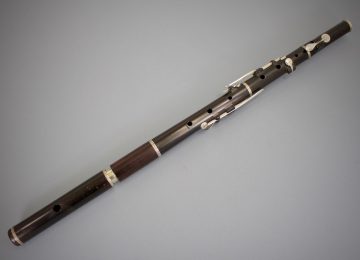Description: This flute is made from cocuswood and has block-mounted, sliver keys (may be very high grade nickel silver) and nickel silver rings. Its head is fully lined in brass. The outer part of the tuning slide is nickel silver. The flute has 6 keys – C, Bb, G#, long and short F, and Eb. The key cups are flat and cylindrical in shape. The touch for the short F key is round, low and depresses into a recess in the flute body. The end cap has internal threads that engage with a threaded cork holder (turned from cocuswood), and can be twisted to fine-tune the stopper position. A nickel silver finial protrudes through the end cap to give a visual indication of the stopper position.
Makers marks: The head is marked “WILLIAM HALL & SON / N-YORK” . The left hand section of the body is marked “WILLIAM HALL & SON / 239 BROADWAY / N-YORK / 8355”. The right hand body and foot sections are both marked “WILLIAM HALL & SON / N-YORK” although the foot marking is quite difficult to read.
History: William Hall was born in Sparta, NY, in 1796 and died in New York in 1874. He worked as an apprentice for Meacham until 1812, when he joined the militia. After the war he worked with John Firth, for E. Riley, in New York. In 1820 he established independently as a musical instrument maker, and in 1821 partnered with Firth as Firth & Hall, and then from 1831 with Sylvanus Pond as Firth, Hall & Pond. In 1847 he established independently, with his son James F. Hall as William Hall & Son. They made pianos in addition to flutes and other instruments, and in 1855 employed 25 men and 5 boys. In 1875 the company was bought by Ditson. They operated at the 239 Broadway address from 1848 to 1849, so this flute is from that narrow time period. For a detailed history of William Hall and his role in early American flute making, see this excellent article by Wendell Dobbs.
Tuning: This flute plays very well at A=440 hz with a lovely voice and great intonation, with the tuning slide extended around 10 mm at 70 degrees F. It would be a good instrument for playing Irish traditional music, especially for those looking for less breath requirement and smaller tone holes that are easier to cover and make crisp ornamentation easier.
Specifications: C# – D# 263 mm. L2 tone hole 7.2 mm. R2 tone hole 7.2 mm.
Condition: The flute is in good playing condition. There are some small marks and indentations in the wood on the head and foot, but these are minor cosmetic issues that have no effect on performance.













